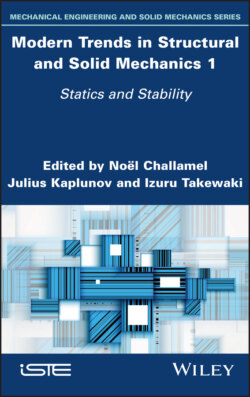Modern Trends in Structural and Solid Mechanics 1

Реклама. ООО «ЛитРес», ИНН: 7719571260.
Оглавление
Группа авторов. Modern Trends in Structural and Solid Mechanics 1
Table of Contents
List of Illustrations
List of Tables
Guide
Pages
Modern Trends in Structural and Solid Mechanics 1. Statics and Stability
Preface. Short Bibliographical Presentation of Prof. Isaac Elishakoff
Books by Elishakoff
Books edited or co-edited by Elishakoff
1. Static Deformations of Fiber-Reinforced Composite Laminates by the Least-Squares Method
1.1. Introduction
1.2. Formulation of the problem
1.3. Results and discussion. 1.3.1. Verification of the numerical algorithm
1.3.2. Simply supported sandwich plate
1.3.3. Laminate with arbitrary boundary conditions
1.4. Remarks
1.5. Conclusion
1.6. Acknowledgments
1.7. References
2. Stability of Laterally Compressed Elastic Chains. 2.1. Introduction
2.2. Compression of stacked elastic sheets
2.3. Stability of an elastically coupled cyclic chain
2.4. Elastic stability of two coupled rods with disorder
2.5. Spatial localization of lateral buckling in a disordered chain of elastically coupled rigid rods
2.6. Conclusion
2.7. References
3. Analysis of a Beck’s Column over Fractional-Order Restraints via Extended Routh–Hurwitz Theorem. 3.1. Introduction
3.2. Material hereditariness
3.2.1. Linear hereditariness: fractional-order models
3.3. Dynamic equilibrium of an elastic cantilever over a fractional-order foundation
3.4. Stability analysis of Beck’s column over fractional-order hereditary foundation
3.4.1. The characteristic polynomial
3.4.2. State-space representation of the dynamic equilibrium equation
3.4.3. Stability analysis of fractional-order Beck’s column via the extended Routh–Hurwitz criterion
3.5. Numerical application
3.6. Conclusion
3.7. References
4. Localization in the Static Response of Higher-Order Lattices with Long-Range Interactions
4.1. Introduction
4.2. Two-neighbor interaction – general formulation – homogeneous solution
4.3. Two-neighbor interaction – localization in a weakened problem
4.4. Conclusion
4.5. References
5. New Analytic Solutions for Elastic Buckling of Isotropic Plates. 5.1. Introduction
5.2. Equilibrium equation
5.3. Solution
5.4. Boundary condition
5.5. Numerical results
5.6. Conclusion
5.7. Appendix A: Deflection, slopes, bending moments and shears
5.8. Appendix B: Function transformation
5.9. References
6. Buckling and Post-Buckling of Parabolic Arches with Local Damage. 6.1. Introduction
6.2. A one-dimensional model for arches
6.2.1. Finite kinematics and balance, linear elastic law
6.2.2. Non-trivial fundamental equilibrium path
6.2.3. Bifurcated path
6.2.4. Special benchmark examples
6.3. Parabolic arches
6.4. Crack models for one-dimensional elements
6.5. An application
6.5.1. A comparison
6.6. Final remarks
6.7. Acknowledgments
6.8. References
7. Inelastic Microbuckling of Composites by Wave-Buckling Analogy. 7.1. Introduction
7.2. Buckling-wave propagation analogy
7.3. Microbuckling in elastic orthotropic composites
7.4. Inelastic microbuckling
7.5. Results and discussion
7.6. References
8. Quasi-Bifurcation of Discrete Systems with Unstable Post-Critical Behavior under Impulsive Loads
8.1. Introduction
8.2. Case study of a two DOF system with unstable static behavior
8.3. Exploring the static and dynamic behavior of the two DOF system
8.4. The dynamic stability criterion due to Lee
8.5. New stability bounds following Lee’s approach
8.6. Conclusion
8.7. Acknowledgments
8.8. References
9. Singularly Perturbed Problems of Drill String Buckling in Deep Curvilinear Borehole Channels. 9.1. Introduction
9.2. Singular perturbation theory: elements and history
9.3. Posing the problem of a drill string buckling in the curvilinear borehole
9.4. Modeling the drill string buckling in lowering operation
9.5. References
10. Shape-optimized Cantilevered Columns under a Rocket-based Follower Force
10.1. Background
10.2. Aims
10.3. Numerical analysis. 10.3.1. Stability analysis
10.3.2. Optimum design
10.3.2.1. Optimization problem I: maximization of critical load under a constant volume
10.3.2.2. Optimization problem II: minimization of volume under a constant critical load
10.3.2.3. Solution by sequential linear optimization
10.3.2.4. Optimality criterion by a single (simple) flutter load
10.4. Experiment. 10.4.1. General description
10.4.2. Rocket motor
10.4.3. Columns
10.4.4. Free vibration test
10.5. Flutter test
10.6. Concluding remarks
10.7. Acknowledgments
10.8. Appendix
10.9. References
11. Hencky Bar-Chain Model for Buckling Analysis and Optimal Design of Trapezoidal Arches
11.1. Introduction
11.2. Buckling analysis of trapezoidal arches based on the HBM
11.2.1. Description of the HBM
11.2.2. HBM stiffness matrix formulation
11.2.3. Governing equation considering compatibility conditions
11.2.4. Verification of the HBM
11.3. Optimal design of symmetric trapezoidal arches. 11.3.1. Problem definition
11.3.2. Optimization procedure
11.3.3. Optimal solutions
11.3.4. Sensitivity analysis of optimal solutions
11.3.5. Comparison with the buckling load of optimal fully stressed trapezoidal arches
11.4. Concluding remarks
11.5. References
List of Authors
Index. A, B, C
D, E, F
G, H, I, J
L, M, N, O
P, R
S, T
U, V, W
Summary of Volume 2
Summary of Volume 3
WILEY END USER LICENSE AGREEMENT
Отрывок из книги
Series Editor
.....
Elishakoff, I. and Ren, Y. (2003). Finite Element Methods for Structures with Large Stochastic Variations. Oxford University Press, Oxford.
Elishakoff, I., Lin, Y.K., Zhu, L.P. (1994). Probabilistic and Convex Modeling of Acoustically Excited Structures. Elsevier, Amsterdam.
.....